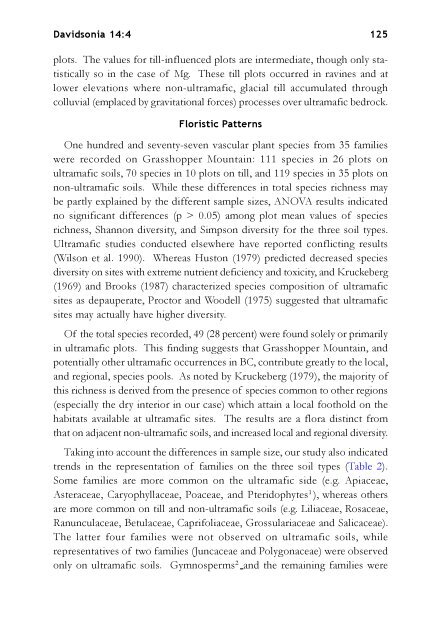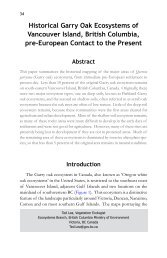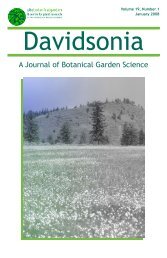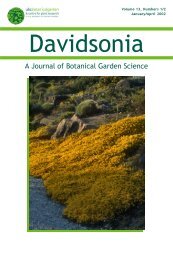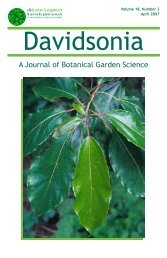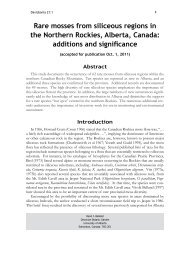pdf wkg Dav.14-14 - Davidsonia
pdf wkg Dav.14-14 - Davidsonia
pdf wkg Dav.14-14 - Davidsonia
Create successful ePaper yourself
Turn your PDF publications into a flip-book with our unique Google optimized e-Paper software.
<strong>Davidsonia</strong> <strong>14</strong>:4<br />
125<br />
plots. The values for till-influenced plots are intermediate, though only statistically<br />
so in the case of Mg. These till plots occurred in ravines and at<br />
lower elevations where non-ultramafic, glacial till accumulated through<br />
colluvial (emplaced by gravitational forces) processes over ultramafic bedrock.<br />
Floristic Patterns<br />
One hundred and seventy-seven vascular plant species from 35 families<br />
were recorded on Grasshopper Mountain: 111 species in 26 plots on<br />
ultramafic soils, 70 species in 10 plots on till, and 119 species in 35 plots on<br />
non-ultramafic soils. While these differences in total species richness may<br />
be partly explained by the different sample sizes, ANOVA results indicated<br />
no significant differences (p > 0.05) among plot mean values of species<br />
richness, Shannon diversity, and Simpson diversity for the three soil types.<br />
Ultramafic studies conducted elsewhere have reported conflicting results<br />
(Wilson et al. 1990). Whereas Huston (1979) predicted decreased species<br />
diversity on sites with extreme nutrient deficiency and toxicity, and Kruckeberg<br />
(1969) and Brooks (1987) characterized species composition of ultramafic<br />
sites as depauperate, Proctor and Woodell (1975) suggested that ultramafic<br />
sites may actually have higher diversity.<br />
Of the total species recorded, 49 (28 percent) were found solely or primarily<br />
in ultramafic plots. This finding suggests that Grasshopper Mountain, and<br />
potentially other ultramafic occurrences in BC, contribute greatly to the local,<br />
and regional, species pools. As noted by Kruckeberg (1979), the majority of<br />
this richness is derived from the presence of species common to other regions<br />
(especially the dry interior in our case) which attain a local foothold on the<br />
habitats available at ultramafic sites. The results are a flora distinct from<br />
that on adjacent non-ultramafic soils, and increased local and regional diversity.<br />
Taking into account the differences in sample size, our study also indicated<br />
trends in the representation of families on the three soil types (Table 2).<br />
Some families are more common on the ultramafic side (e.g. Apiaceae,<br />
Asteraceae, Caryophyllaceae, Poaceae, and Pteridophytes 1 ), whereas others<br />
are more common on till and non-ultramafic soils (e.g. Liliaceae, Rosaceae,<br />
Ranunculaceae, Betulaceae, Caprifoliaceae, Grossulariaceae and Salicaceae).<br />
The latter four families were not observed on ultramafic soils, while<br />
representatives of two families (Juncaceae and Polygonaceae) were observed<br />
only on ultramafic soils. Gymnosperms 2 and the remaining families were


